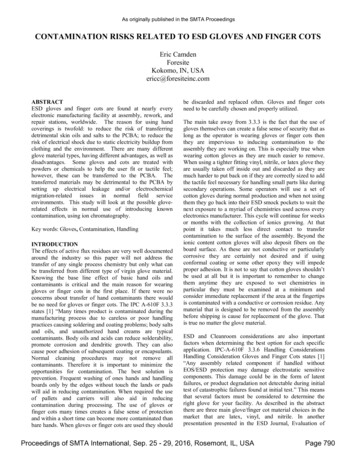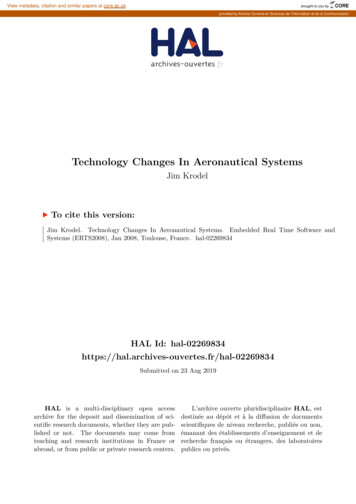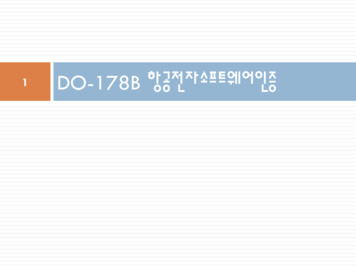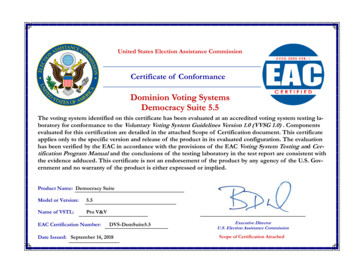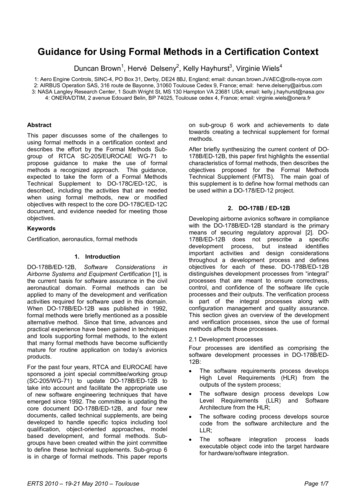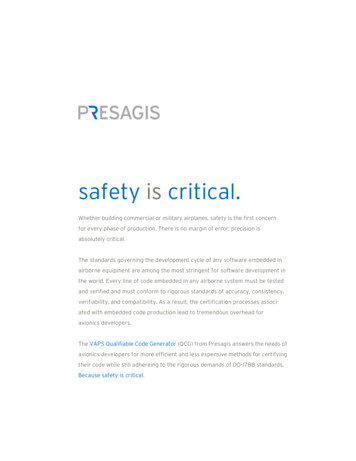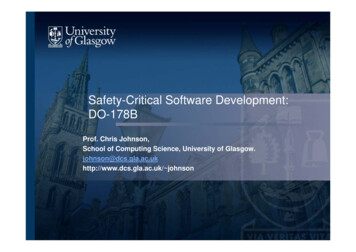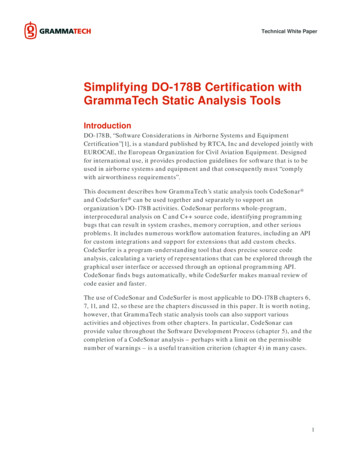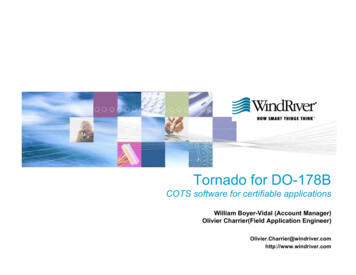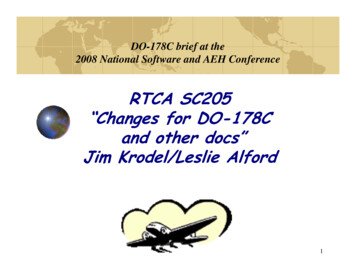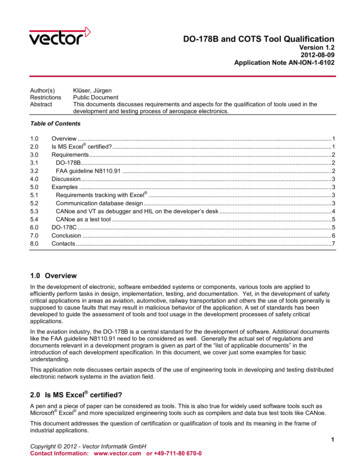
Transcription
DO-178B and COTS Tool QualificationVersion 1.22012-08-09Application Note AN-ION-1-6102Author(s)RestrictionsAbstractKlüser, JürgenPublic DocumentThis documents discusses requirements and aspects for the qualification of tools used in thedevelopment and testing process of aerospace electronics.Table of Overview . 1 Is MS Excel certified? . 1Requirements . 2DO-178B. 2FAA guideline N8110.91 . 2Discussion . 3Examples . 3 Requirements tracking with Excel . 3Communication database design . 3CANoe and VT as debugger and HIL on the developer’s desk . 4CANoe as a test tool . 5DO-178C . 5Conclusion . 6Contacts . 71.0 OverviewIn the development of electronic, software embedded systems or components, various tools are applied toefficiently perform tasks in design, implementation, testing, and documentation. Yet, in the development of safetycritical applications in areas as aviation, automotive, railway transportation and others the use of tools generally issupposed to cause faults that may result in malicious behavior of the application. A set of standards has beendeveloped to guide the assessment of tools and tool usage in the development processes of safety criticalapplications.In the aviation industry, the DO-178B is a central standard for the development of software. Additional documentslike the FAA guideline N8110.91 need to be considered as well. Generally the actual set of regulations anddocuments relevant in a development program is given as part of the “list of applicable documents” in theintroduction of each development specification. In this document, we cover just some examples for basicunderstanding.This application note discusses certain aspects of the use of engineering tools in developing and testing distributedelectronic network systems in the aviation field.2.0 Is MS Excel certified?A pen and a piece of paper can be considered as tools. This is also true for widely used software tools such as Microsoft Excel and more specialized engineering tools such as compilers and data bus test tools like CANoe.This document addresses the question of certification or qualification of tools and its meaning in the frame ofindustrial applications.Copyright 2012 - Vector Informatik GmbHContact Information: www.vector.com or 49-711-80 670-01
DO-178B and COTS Tool QualificationDO-178B, as an important document for software requirements, uses the term “qualification” instead of“certification”. Therefore, in the following the term “qualification” is used.3.0 Requirements3.1 DO-178BDO-178B defines requirements for the qualification of tools. According to Section 12.2, tool qualification is onlyneeded when processes described in DO-178B are eliminated, reduced, or automated by use of that tool withoutits output being verified as specified in DO-178B Section 6.If a tool provides results that are taken as input for subsequent development steps of safety critical items, withoutany additional evidence of integrity verification, DO-178B, Section 12.2 requires that the tool must be qualified.There is no need to qualify the tool if the output of the tool is verified by other means.Furthermore, DO-178B classifies software tools as one of two types: Software development tools: These are “tools whose output is part of airborne software and thus canintroduce errors.”Software verification tools: These are "tools that cannot introduce errors, but may fail to detect them."3.2 FAA guideline N8110.91FAA guideline N8119.91 provides good examples of guidelines, clarifications and further requirements describingthe regulations for a development program. Its stated purpose: “This notice clarifies the application of DO-178B inthe area of tool qualification but does not change the intent of DO-178B in this area.”In the following DER means Designated Engineering Representative, ACO means Aircraft Certification Office.After discussing background information, it provides guidelines for determining whether a tool should be qualified:(1) Whether a tool needs to be qualified is independent of the type of the tool (development orverification). There are three questions to ask to determine if a tool needs qualification. If the answeris “Yes” to all of the questions below, the tool should be qualified:(a) Can the tool insert an error into the airborne software or fail to detect an existing error in thesoftware within the scope of its intended usage?(b) Will the tool’s output not be verified as specified in Section 6 of DO-178B?(c) Are processes of DO-178B eliminated, reduced, or automated by the use of the tool? That is, willthe output from the tool be used to either meet an objective or replace an objective of DO-178B,Annex A?Furthermore, N8110.91 states the following:(2) Once it has been determined that a tool does not require qualification, the remainder of DO-178BSection 12.2 is not applicable to that tool. In order to ensure timely response, the cognizant ACOengineer or DER (if authorized) should be involved early in the certification project’s tool qualificationagreements.(3) The Plan for Software Aspects of Certification (PSAC) should include a listing of all software tools andjustification for why each tool does or does not require qualification.If this leads to a decision that a tool needs qualification, N8110.91 provides a table of qualification criteria,depending on whether the tool is a development tool or a verification tool. One criterion for both of these types isthe determinism of the tool. The document discusses the problems of tools with graphical user interfaces – theyare by design not deterministic. Qualification may still be possible, but will require a very deep analysis.Application Note AN-ION-1-61022
DO-178B and COTS Tool Qualification4.0 DiscussionSoftware development is a very complex process with repetitive time-consuming tasks. Existing software tools fromthe COTS market as well as specifically developed software tools are used to help in this process. Without some ofthese tools, such as compilers, software development would not even be possible.In theory, it is adequate to develop such tools according to the very same goals as applied to the airborne softwareitself. However, if object oriented methods are applied it must be assured that object oriented code will not includedead code and that the code can directly be linked to detail requirements. The upcoming DO-178C will help byproviding guidelines to achieve these goals. Nonetheless, the use of COTS tools will still be problematic.Discussions with engineers involved in the verification and certification process of aircraft systems (e.g. DER,ACO, office of airworthiness) led to the recommendation that the output of a tool should not be trusted at all, evennot the output of qualified tools. In any case, the output should be reviewed or proven by other mechanisms. Asoutlined in 3.1 and 3.2, in that case there is no need to qualify the tool. This significantly reduces cost and effortand allows the use of COTS tools.5.0 ExamplesThe following examples provide a base for discussion of some use cases. They are significantly simplified toillustrate their basic features. Besides an example of the commercially mass-produced tool Excel, other examplesfocus on engineering tools available from Vector.5.1 Requirements tracking with Excel Consider the management of important data in a tool like Excel. This may concern test case management orrequirements listing and management. In the latter case, the correctness of the data will directly influence thecorrectness of the airborne software. Even final testing may not detect lost requirements, since test cases aredesigned according to the requirements list.Excel has a graphical user interface. The function or the content of a cell may be influenced by other Excel sheetsbecause of VBA programming features that can override Excel cell application content or functions, even ifinterfering sheets are not directly linked. This violates the principle of determinism. Ensuring a consistent,completely well-defined environment is practically impossible.Even if the manufacturer were willing to cooperate in qualification, this would not make any sense with Excel forpractical and business reasons.The solution to the problem however, is quite simple by means of “checker mechanisms”: The requirements listneeds to be exported in a simple format that easily can be reviewed, as well as simply compared to master files.After a review of the completeness of the requirements in the exported format, the exported file can serve as a newmaster file. If modifications have been made, correctness and completeness can easily be verified by comparisonof the export file with the master file and the modification item list. The verified and corrected export file after thisagain, becomes the new master file.Approaching like this, Excel does not need qualification.5.2 Communication database designEngineering of functions communicating via data buses requires communication management. For some databuses, certain standard file formats are used; for others, proprietary solutions exist. Vector offers tools like theCANdb editor, network designers and more. For about 20 years now, the CANdb database format DBC is a defacto standard for the CAN data bus in a number of industries. This format can be managed by a tool such as theCANdb editor.Such databases are used by designers of network systems, function developers, developers of LRU software, andtest departments. Therefore, errors in the CANdb editor could have a critical impact on the airborne software,Application Note AN-ION-1-61023
DO-178B and COTS Tool Qualificationwhich would not necessarily be detected by tests. According to section 3.1 of this paper such a tool belongs to thecategory of software development tools.The storage format is an ASCII format. Conducting a review in conjunction with an independent comparison toolmakes it possible to verify completeness and identify differences on base of master files (refer to 5.1).When such methods are applied, the CANdb editor can be used without qualification.5.3 CANoe and VT as debugger and HIL on the developer’s deskComplex electronic functions generally are realized as distributed systems being connected via data buses. Whendeveloping software for an electronic device (e.g. LRU) in such distributed environment, one particular difficultyoccurs. Parts of the overall functionality may not yet be available, although their data communication is needed ona data bus for design purposes. The communication partner may not be available yet. In those cases a substitutecommunication partner is necessary.Another situation is debugging. The location of a bug may not be known, when it occurs somewhere amongdistributed devices. This results in very high debugging effort.In these and other cases, a simulation tool like CANoe helps. CANoe provides users a detailed insight to the databus – from the frame level to the functional level. It provides a communication partner in early developmentphases, or it may substitute a simulated model for a communication partner to detect bugs in an environmentwhere it is not feasible to acquire the necessary critical values from the physical devices. By supporting severaldifferent bus systems in parallel, it helps in developing functions via gateways. And by including additional I/O,either directly or with the help of test hardware such as the Vector VT system; it can be scaled to a comfortablesmall or medium HIL system – on the developer’s desk.Tool assistance as described above significantly boosts development efficiency. It eliminates or at least reducesdebugging problems that would otherwise cause excessive effort. Its primary strength is to identify hiddenproblems in early development phases, which avoids unnecessary process cycle iterations.When used as described here, the tool does not “eliminate, reduce, or automate” processes. The actual verificationof the communication integrity will be performed by system tests at later process stages, when all devices are athand. The tool simply improves design process efficiency and helps to gain time and cost savings. So qualificationis not required.Figure 1: Tests during development in the V modelApplication Note AN-ION-1-61024
DO-178B and COTS Tool Qualification5.4 CANoe as a test toolTest tools cannot “insert an error into the airborne software,” but they may “fail to detect an existing error”. So theyneed to be qualified if “the tool’s output is not verified”. According to 4.0, standard testing procedures shouldalways verify results. For example, this can be done as shown in Figure 2.Test CaseGeneratorTest CaseEditorTestModule(XML)XYZas t(XML)Test Management System maps test cases to test objectsmanages test resultstracks test progress of each test object versionConfiguration Management SystemFigure 2: Testing with diversified test executionTest management provides the test cases, which than are executed by different independently developed testexecution tools. Finally, the resulting test reports need to be compared and approved.This approach provides at least the same – but generally even more - confidence as the use of a single qualifiedtool. As a matter of fact, the described approach saves much cost compared to the qualification of a tool.6.0 DO-178CThe new version DO-178C “Software Considerations in Airborne Systems and Equipment Certification” wasreleased in December 2011. Written by many contributing experts it now considers modern software developmentaspects and provides guidance about their use. The categorization of tools into development tools and testing toolsis replaced by a categorization with 3 criteria.The first step always needs to be the determination if a tool has to be qualified. This is needed when processes ofthe DO-178C are eliminated, reduced, or automated by the use of the tool without its output being verified asspecified in other sections of DO-178C. A tool is qualified only for use on a specific system. Using it in a differentsystem requires a new qualification.If a tool needs qualification the tool qualification level TQL needs to be determined. As guidance three criteria aredefined:Criteria 1:Criteria 2:Criteria 3:A tool whose output is part of the airborne software and thus could insert an error.A tool that automates verification processes and thus could fail to detect an error, and whoseoutput is used to justify the elimination or reduction of:1. Verification processes other than that automated by the tool, or2. Development processes that could have an impact on the airborne software.A tool that, within the scope of its intended use, could fail to detect an error.Application Note AN-ION-1-61025
DO-178B and COTS Tool QualificationFive levels of tool qualification, TQL-1 to TQL-5, are identified based on the tool use and its potential impact in thesoftware life cycle processes.Software QL-4TQL-5TQL-53TQL-5TQL-5TQL-5TQL-5The details about the tool qualification are described in DO-330 “Software Tool Qualification Considerations”.The current aircraft programs use previous versions of these documents. Therefore there is not much practicalexperience with the new documents. First projects will show how they have to be used and which topics will needfurther interpretation.7.0 ConclusionEngineering tools today, are indispensable elements within the development and integration processes of complexsystems. They provide a deep insight to the features of the design items and their mutual interoperation. They helpto detect design errors at early development stages, and to debug the integrated system at the final phases of thedevelopment cycle. In order to achieve an adequate integrity level the tools being applied in the frame of theprocesses have to prove a high quality. For this purpose all tools being used for the design, integration andverifications of critical system devices have to be listed in the PSAC and must be approved by detailed agreementsfrom the responsible ACO engineers or DER. However, this does not necessarily include the need for thoroughtool qualification. The application of commercial-off-the-shelf tools always is admissible if their qualification issubstituted by appropriate checker mechanisms as outlined in this paper. Going this way in general savesconsiderable project costs, while attaining the same or even better confidence and integrity levels than byexpensive tool qualification.Trademarks used in this document are the property of their respective owners.Application Note AN-ION-1-61026
DO-178B and COTS Tool Qualification8.0 ContactsGermanyand all countries not named below:France, Belgium, Luxemburg:Sweden, Denmark, Norway,Finland, Iceland:Vector Informatik GmbHIngersheimer Str. 2470499 StuttgartGERMANYPhone: 49 711-80670-0Fax: 49 711-80670-111E-mail: info@de.vector.comVector France S.A.S.168, Boulevard Camélinat92240 MalakoffFRANCEPhone: 33 1 42 31 40 00Fax: 33 1 42 31 40 09E-mail: information@fr.vector.comVecScan ABTheres Svenssons Gata 941755 GöteborgSWEDENPhone: 46 31 764 76 00Fax: 46 31 764 76 19E-mail: info@se.vector.comUnited Kingdom, Ireland:China:India:Vector GB Ltd.Rhodium, Central BoulevardBlythe Valley ParkSolihull, BirminghamWest Midlands B90 8ASUNITED KINGDOMPhone: 44 121 50681-50Fax: 44 121 50681-69Vector Informatik India Pvt. Ltd.4/1/1/1, Sutar Icon, Sus Road,Pashan, Pune - 411 021INDIAE-mail: info@uk.vector.comVector Automotive Technology(Shanghai) Co., Ltd.Sunyoung CenterRoom 1701, No.398 Jiangsu RoadChangning DistrictShanghai 200050P.R. CHINAPhone: 86 21 6432 53530Fax: 86 21 6432 5308E-mail: info@cn.vector.comUSA, Canada, Mexico:Japan:Korea:Vector CANtech, Inc.39500 Orchard Hill Place, Suite 550Novi, MI 48375USAVector Japan Co. Ltd.Tennozu Yusen Bldg. 16F2-2-20 Higashi-shinagawa,Shinagawa-ku,Tokyo 140-0002JAPANPhone: 81 3 5769 7800Fax: 81 3 5769 6975E-mail: info@jp.vector.comVector Korea IT Inc.5F, Gomoas bldg.12 Hannam-daero 11-gil, Yongsan-guSeoul, 140-889REPUBLIC OF KOREAPhone: 1 248 449 9290Fax: 1 248 449 9704E-mail: info@us.vector.comApplication Note AN-ION-1-6102Phone: 91 20 2587 2023Fax: 91 20 2587 2025E-mail: info@in.vector.comPhone: 82 2 807 0600Fax: 82 2 807 0601E-mail: info@kr.vector.com7
3.1 DO-178B DO-178B defines requirements for the qualification of tools. According to Section 12.2, tool qualification is only needed when processes described in DO-178B are eliminated, reduced, or automated by use of that tool without its output being verified as specified in DO-178B Section 6.
